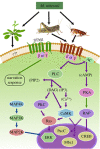Metarhizium: jack of all trades, master of many
- PMID: 33292103
- PMCID: PMC7776561
- DOI: 10.1098/rsob.200307
Metarhizium: jack of all trades, master of many
Abstract
The genus Metarhizium and Pochonia chlamydosporia comprise a monophyletic clade of highly abundant globally distributed fungi that can transition between long-term beneficial associations with plants to transitory pathogenic associations with frequently encountered protozoans, nematodes or insects. Some very common 'specialist generalist' species are adapted to particular soil and plant ecologies, but can overpower a wide spectrum of insects with numerous enzymes and toxins that result from extensive gene duplications made possible by loss of meiosis and associated genome defence mechanisms. These species use parasexuality instead of sex to combine beneficial mutations from separate clonal individuals into one genome (Vicar of Bray dynamics). More weakly endophytic species which kill a narrow range of insects retain sexuality to facilitate host-pathogen coevolution (Red Queen dynamics). Metarhizium species can fit into numerous environments because they are very flexible at the genetic, physiological and ecological levels, providing tractable models to address how new mechanisms for econutritional heterogeneity, host switching and virulence are acquired and relate to diverse sexual life histories and speciation. Many new molecules and functions have been discovered that underpin Metarhizium associations, and have furthered our understanding of the crucial ecology of these fungi in multiple habitats.
Keywords: Metarhizium and Pochonia chlamydosporia; insect killing (entomopathogen); parasexual and asexual life histories (Red Queen and Vicar of Bray); parasitism to insects or nematodes; plant endophyte and symbiont; sexual; virulence evolution (host switching and speciation).
Conflict of interest statement
The authors declare that they have no competing interests.
Figures





Similar articles
-
Advances in Genomics of Entomopathogenic Fungi.Adv Genet. 2016;94:67-105. doi: 10.1016/bs.adgen.2016.01.002. Epub 2016 Mar 14. Adv Genet. 2016. PMID: 27131323 Review.
-
The evolution of complex Metarhizium-insect-plant interactions.Fungal Biol. 2024 Dec;128(8 Pt B):2513-2528. doi: 10.1016/j.funbio.2024.01.001. Epub 2024 Jan 6. Fungal Biol. 2024. PMID: 39653497 Review.
-
Clarification of generic and species boundaries for Metarhizium and related fungi through multigene phylogenetics.Mycologia. 2014 Jul-Aug;106(4):811-29. doi: 10.3852/13-319. Epub 2014 Jun 2. Mycologia. 2014. PMID: 24891418
-
The multifunctional lifestyles of Metarhizium: evolution and applications.Appl Microbiol Biotechnol. 2020 Dec;104(23):9935-9945. doi: 10.1007/s00253-020-10968-3. Epub 2020 Oct 21. Appl Microbiol Biotechnol. 2020. PMID: 33085023 Review.
-
Insect pathogens as biological control agents: Back to the future.J Invertebr Pathol. 2015 Nov;132:1-41. doi: 10.1016/j.jip.2015.07.009. Epub 2015 Jul 27. J Invertebr Pathol. 2015. PMID: 26225455 Review.
Cited by
-
Metarhizium brunneum (Hypocreales: Clavicipitaceae) and Its Derived Volatile Organic Compounds as Biostimulants of Commercially Valuable Angiosperms and Gymnosperms.J Fungi (Basel). 2022 Oct 8;8(10):1052. doi: 10.3390/jof8101052. J Fungi (Basel). 2022. PMID: 36294617 Free PMC article.
-
Effects of tomato inoculation with the entomopathogenic fungus Metarhizium brunneum on spider mite resistance and the rhizosphere microbial community.Front Microbiol. 2023 May 24;14:1197770. doi: 10.3389/fmicb.2023.1197770. eCollection 2023. Front Microbiol. 2023. PMID: 37293220 Free PMC article.
-
An overview of symbiotic and pathogenic interactions at the fungi-plant interface under environmental constraints.Front Fungal Biol. 2024 Oct 25;5:1363460. doi: 10.3389/ffunb.2024.1363460. eCollection 2024. Front Fungal Biol. 2024. PMID: 39524061 Free PMC article. Review.
-
Bioinoculant-induced plant resistance is modulated by interactions with resident soil microbes.Environ Microbiome. 2025 Jan 18;20(1):7. doi: 10.1186/s40793-025-00667-9. Environ Microbiome. 2025. PMID: 39827166 Free PMC article.
-
Insect hosts are nutritional landscapes navigated by fungal pathogens.Ecology. 2025 Feb;106(2):e70015. doi: 10.1002/ecy.70015. Ecology. 2025. PMID: 39918029 Free PMC article.
References
-
- Lord JC. 2005. From Metchnikoff to Monsanto and beyond: the path of microbial control. J. Invert. Pathol. 89, 19–29. - PubMed
-
- Butt TM, Coates CJ, Dubovskiy IM, Ratcliffe NA. 2016. Entomopathogenic fungi: new insights into host–pathogen interactions. In Advances in genetics, vol. 94, pp. 307–364. New York, NY: Academic Press. - PubMed
-
- Lu HL, St. Leger RJ. 2016. Insect immunity to entomopathogenic fungi. In Advances in genetics, Vol. 94, pp. 251–285. Academic Press. - PubMed
Publication types
MeSH terms
LinkOut - more resources
Full Text Sources

